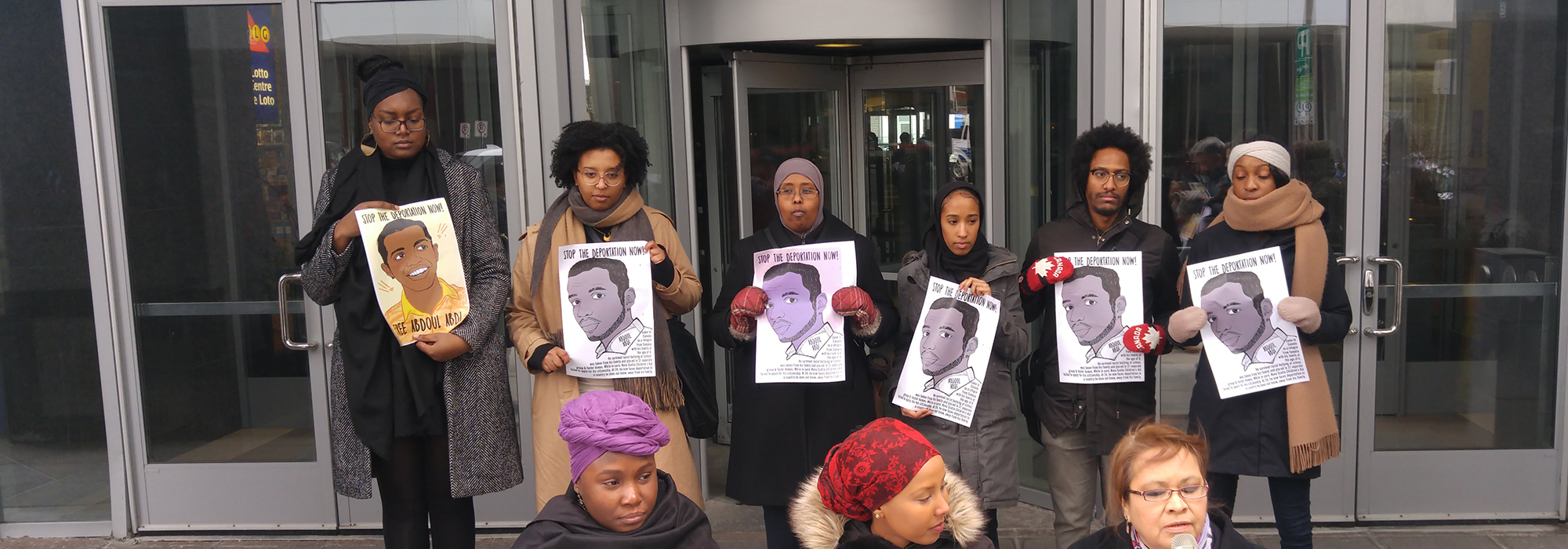
This article has been translated into French.
Over the last few months, the case of Abdoul Abdi, a young Somali refugee and former Crown ward facing deportation for being convicted of crimes, has sparked outrage nationwide.
Abdi, now age 24, arrived in Nova Scotia at the age of six with his sister and aunts after his mother died in a refugee camp. He was removed from his family and placed in 31 foster care and group home placements throughout his childhood and adolescence.
During his time under Crown care, no one applied for Canadian citizenship on his behalf. He also developed behavioural problems as a reaction to childhood trauma and ongoing displacement, but his needs were not adequately met by the system. At the age of 20, shortly after ‘’aging out’’ of Crown care, he pleaded guilty to several charges, including aggravated assault, and was sentenced to four and a half years in prison. He has since been released and is residing in a halfway home in Toronto, awaiting a decision that could endanger his life.
Abdi’s case is not unique to refugees. Unfortunately, many Canadian youth involved in the child protection system tend to end up in the criminal justice system at one point or another. Findings from a 2009 report by the BC Representative for Children and Youth paint a grim picture: It was more likely for youth in care to end up in the youth justice system (36 percent) than to graduate high school (26 percent).
This was in stark contrast to youth in the general population, who were far less likely to be recommended for charges by the police (six percent) than youth in care (41 percent). The report also noted that youth in care in BC had a one in six chance of being detained or sentenced to custody, compared to a one in 50 chance for youth who were not in care. The rates of incarceration are even higher for minority youth; African-Canadian youth are overrepresented by more than 300 percent while Indigenous youth are overrepresented by over 500 percent compared to their representation in the general population.
Referred to in the research community as “crossover youth,” their involvement of these young adults in both the child protection and criminal justice systems is often the result of ongoing trauma that goes untreated, of multiple placements, of zero-tolerance policies in group homes and of various government ministry silos that allow troubled youth to fall between the cracks. The child protection system also tends to criminalize youth who exhibit behavioural problems, which has been highlighted in multiple reports including the New Brunswick Child and Youth Advocate’s 2008 reports Connecting the Dots and The Ashley Smith Report.
Ashley Smith’s death at age 18 while in federal custody in Ontario was a national human rights scandal. She spent most of her adolescence in and out of the criminal justice system, with inordinate amounts of time in solitary confinement. Smith had a long history of mental health issues that were never adequately treated. They resulted in behavioural issues and cries for help, multiple criminal charges and ultimately her death.
Police officer training is mostly focused on punitive responses such as detention and arrests that can make children and youth feel as though they’re being apprehended rather than moved to a safer place.
This cycle of involvement with the justice system for youth in care should be no surprise given interaction with law enforcement begins as soon as they enter into the child welfare system. Police officers are the first point of contact in removing children and youth from their families and placing them into care. Police officer training is mostly focused on punitive responses such as detention and arrests that can make children and youth feel as though they’re being apprehended rather than moved to a safer place. They are also made to feel like criminals during their time in care through over-surveillance, punitive responses and restrictions that their peers are not subjected to. These dehumanizing experiences increase their likelihood of involvement in the criminal justice system as children and youth tend to act out what they learn from adults.
How can we break the cycle for “crossover youth?” Whether you are a policy-maker, a front-line worker, a judge, a law enforcement officer, an academic, an advocate or a concerned citizen, we each have a role to play in paving the way for systemic change.
First, we need to listen to the valuable expertise of youth who have been through these experiences, compile meaningful and collaborative research, and develop programs and interventions tailored to their needs.
Second, we need to keep crossover youth in their communities rather than locking them up in correctional institutions devoid of connections to the people who matter to them. While youth incarceration has been proven to be largely ineffective in preventing further crimes, cost- benefit analyses show that community-based programs and interventions produce better results and at a fraction of the cost.
In many cases, community-based programs utilizing a restorative justice approach – one based on Indigenous justice themes of community healing, mediation and resolution — show more promise than punitive approaches. This is especially important for Indigenous youth since ongoing systemic discrimination and colonization has caused their overrepresentation in both the child welfare and youth justice systems.
Often, youth in the justice system are involved with multiple government ministries, with multiple case files and front-line workers who do not always communicate with each other when making decisions.
Third, we need to break down the silos and work collaboratively on bridging service delivery gaps to meet the needs of children and youth in care far before they start falling through the cracks. Often, youth in the justice system are involved with multiple government ministries, with multiple case files and front-line workers who do not always communicate with each other when making decisions that affect the lives of youth under their care. We need an interdisciplinary and holistic approach to prevention and intervention, and to address the needs of children and youth in care from a trauma-informed approach — one that recognizes trauma, its prevalence and its impacts for youth in and from care. The New Brunswick Integrated Service Delivery project for children and youth with emotional, behavioural and mental health issues, in place since 2011, is a promising best practice that other provinces should be looking to when coming up with their own service delivery reforms.
Fourth, we need to provide front-line workers with training from a trauma-informed perspective, as most children and youth in care are suffering from ongoing trauma and are often misunderstood by those involved in their lives. When trauma is not recognized or addressed, children and youth are more likely to cope through destructive and delinquent behaviours. Canadian statistics show that more than half of inmates have previous involvement with the child welfare system. A lack of trauma-informed practices also puts children and youth in care at risk of being subjugated to traumatic experiences by the very workers who are paid to take care of them.
And finally, we need to stop treating youth experiencing mental health issues like criminals and start showing them compassion, care and dignity. Youth in care who exhibit behavioural issues should be considered troubled rather than labelled as trouble, as often their behaviour is a symptom of complex underlying issues such as victimization, ongoing trauma and displacement.
We need to remember that children and youth who are placed into care have often been both witnesses to and victims of unspeakable violence, abuse and neglect, which they carry with them throughout their time in care. Without the proper care and support, we cannot expect them to magically recover from their trauma and become thriving citizens. We also need to invest in more community-based mental health programs, eliminate waiting lists and meet the needs of youth in a timely manner so that prisons cease to serve as de-facto mental health institutions.
This article is part of the Widening the Lens on Criminal Justice Reform special feature.
Photo: OTTAWA – A demonstration in support of Abdoul Abdi, March 6, 2018. Photo by Aditya Rao.
Do you have something to say about the article you just read? Be part of the Policy Options discussion, and send in your own submission. Here is a link on how to do it. | Souhaitez-vous réagir à cet article ? Joignez-vous aux débats d’Options politiques et soumettez-nous votre texte en suivant ces directives.











